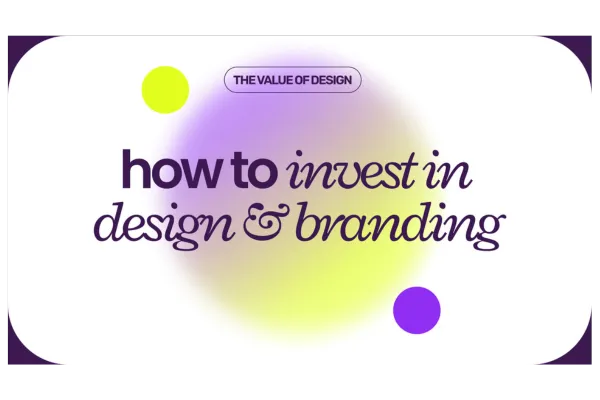
How to Invest in Design and Branding
How to Invest in Design and Branding
Investing in design and branding should be part of the critical strategy for companies aiming to establish a strong presence and build lasting relationships with customers.
Here's how companies generally approach this investment, the costs involved, and the pros and cons of managing design and branding in-house versus outsourcing to external agencies
1. Identifying Needs and Goals
When deciding to invest in design and branding, a strategic assessment of needs and goals is crucial for ensuring your investments yield optimal results!
Here’s a structured approach on how you can effectively assess your needs and set clear goals:
Conduct a Brand Audit
Identify Gaps and Opportunities
Understand the Market and Competitors
Competitor Analysis
Align with Business Objectives
Set Specific Branding Goals
Define Target Audience
Customer Personas
Assess Design Capabilities and Resources
Budget Planning
Plan for Implementation and Measurement
Measurement and KPIs
2. Budget Allocation:
Investment in design and branding can vary widely based on the company’s size, industry, and specific goals. Budgets are allocated for various activities, including hiring talent, purchasing tools and software, conducting market research, and funding marketing campaigns.
Here’s a typical approach on how a small business might allocate a $10,000 design and branding budget:
Initial Assessment and Planning: $500 - $1,000
Visual Identity Development: $2,000 - $3,000
Website and Digital Presence: $3,000 - $4,000
Marketing Materials: $1,000 - $2,000
Launch and Promotion: $1,000 - $1,500
Monitoring and Adjusting: $500 - $1,000
By carefully planning and allocating the budget in stages, small businesses can manage costs while still creating a powerful and professional brand presence. This structured approach ensures that every dollar spent is likely to provide a return in terms of increased visibility, customer trust, and ultimately sales.
3. Strategy Development
Developing a design and branding strategy that aligns with a company's overall business objectives is crucial for ensuring that branding efforts drive real business results.
Here are some questions to ask to start creating a strategy that synchronizes design and branding with broader business goals:
Are the goals to enter new markets, launch new products, increase market share, improve customer retention, or enhance profitability through premium offerings?
How are customers, and the market, perceiving the brand?
Are there areas where the brand is performing well, are there areas of disconnect?
Is your target audience clearly defined?
What is your brand positioning statement?
How do you differentiate yourself from competitors?
Do you have a consistent brand look, message, and voice across all communications?
Does your brand’s identity align with your business goals?
Have you identified key performance indicators (KPIs) that will measure the effectiveness of the design and branding efforts?
A well-aligned design and branding strategy serves as a powerful driver for achieving business objectives. By systematically analyzing the company's goals, market position, and customer insights, businesses can develop a branding strategy that not only resonates with customers but also significantly enhances overall business performance. This approach ensures that every element of the company’s brand is working towards the same business goals, creating synergy across operations and marketing efforts.
4. Execution
Execution may involve the design or redesign of logos, websites, product packaging, and other marketing materials. Executing the design and branding of a new company involves a series of strategic steps to ensure that the brand resonates effectively with the target audience and establishes a strong presence across various channels.
Here’s a step-by-step plan for how to roll out design and branding messages effectively:
Step 1: Define the Brand Identity
Step 2: Craft Brand Messaging
Step 3: Build a Strong Online Presence
Step 4: Develop Marketing Materials
Step 5: Launch the Brand
Step 6: Implement Integrated Marketing Campaigns
Step 7: Continuously Engage and Optimize
There are countless pieces in all the above steps that make up the secret sauce of Brandspot’s strategic approach to design and branding.
Launching new design and branding requires meticulous planning and a consistent approach across all channels.
The key is to maintain consistency while being responsive to market feedback and evolving the brand over time.
5. Monitoring and Adjusting
Post-implementation, companies monitor the effectiveness of their design and branding efforts through customer feedback, sales data, and other metrics. Adjustments are made as necessary to enhance the strategy.
There are for tracking engagement and the effectiveness of different channels, and the use of analytics makes it simple to adjust marketing strategies based on performance data.
The smartest way to find out how effective your design and branding is is to have a continuous feedback and engagement loop with your customers to optimize and evolve your brand.
Regularly collect and analyze customer feedback to understand brand perception. Use those insights to refine branding and marketing strategies.
Staying adaptive to market changes and evolving as necessary will keep your brand and design fresh and relevant.
Costs Involved
Costs can range from a few thousand dollars for small startups, to millions for large enterprises. For example:
Small Businesses might spend anywhere from $2,000 to $50,000 on initial branding and design efforts
Mid-sized Companies could invest between $50,000 to $200,000
Large Corporations might allocate several hundred thousand to millions of dollars, especially if the branding initiative is global
These costs include creative development, market research, tool and software licenses, and implementation across various media.
In-house vs Outsourcing
In-house Pros:
Control: Having an in-house team gives companies greater control over the branding process and ensures that the team is fully aligned with the company's culture and goals.
Cost-Effective for Long Term: For organizations that require continuous design work, maintaining an in-house team can be more cost-effective.
Faster Communication: Internal teams allow for more straightforward communication and quicker feedback loops.
In-house Cons:
High Initial Investment: Recruiting, hiring, and training a skilled design team can be costly and time-consuming.
Resource Limitations: Smaller companies might not have the resources to attract top talent or might be limited in the range of skills they can bring on board.
Outsourcing Pros:
Access to Expertise: Outsourcing provides access to top talent and the latest industry practices without the long-term commitment of hiring full-time employees.
Flexibility: Companies can scale their branding efforts up or down based on current needs without the overhead of maintaining a full-time team.
Innovative Perspectives: External agencies bring fresh perspectives that can inject new ideas into your brand’s strategy.
Outsourcing Cons:
Less Control: Outsourcing can result in less control over the branding process and output.
Potential for Misalignment: There is a risk that the external agency might not fully understand or align with the company's vision and culture.
Cost: While outsourcing can be flexible, it can also be more expensive in the short term, especially for high-quality services.
Deciding between in-house and outsourcing depends largely on the company’s specific needs, budget, and strategic goals. Some companies opt for a hybrid model, maintaining a small in-house team while also working with external agencies to benefit from both setups. Regardless of the approach, investing in design and branding is essential for companies wanting to stand out in a competitive market and resonate deeply with their customers.
Are you ready to elevate your business through strategic design and impactful branding?
Get your copy of Understanding the Value of Design white paper today to learn more.
